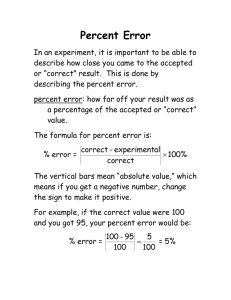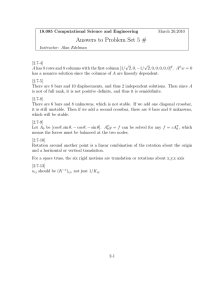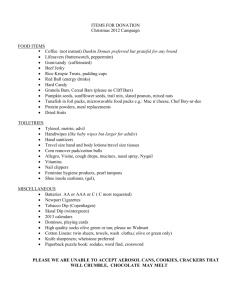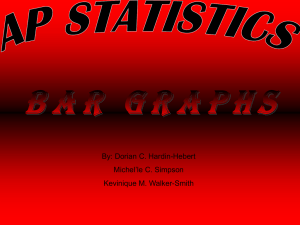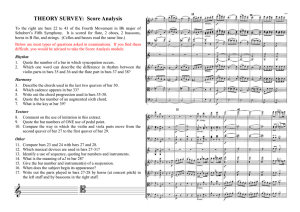FORMATION OF STATIONARY ALTERNATE BARS IN A FLUME EXPERIMENT
advertisement
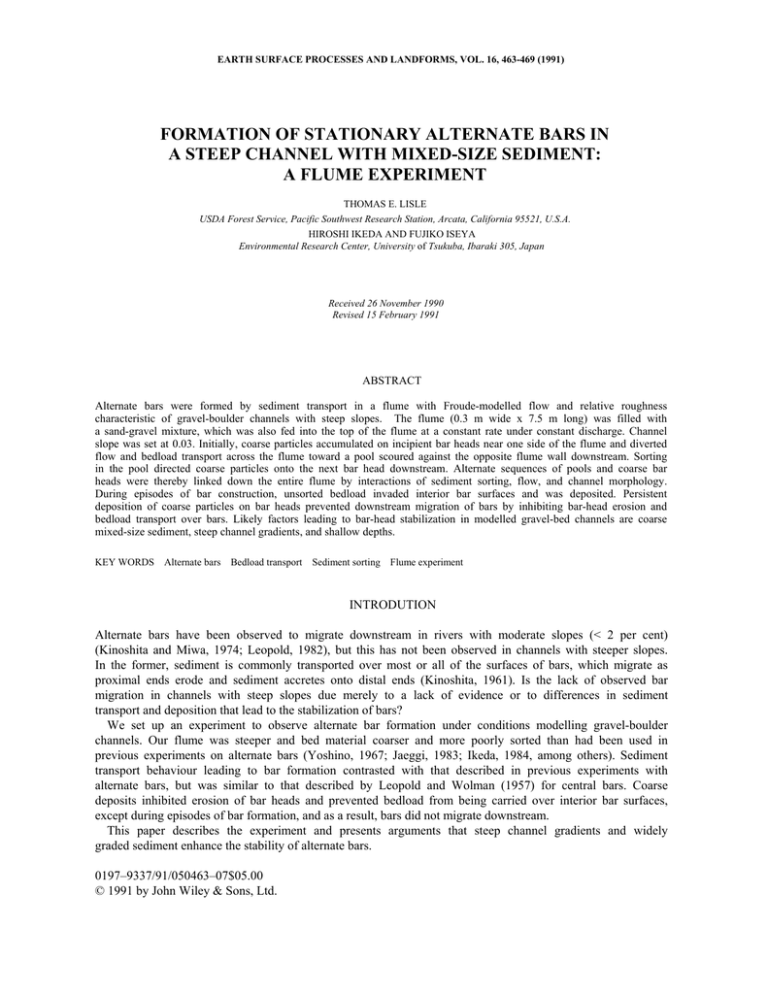
EARTH SURFACE PROCESSES AND LANDFORMS, VOL. 16, 463-469 (1991)
FORMATION OF STATIONARY ALTERNATE BARS IN
A STEEP CHANNEL WITH MIXED-SIZE SEDIMENT:
A FLUME EXPERIMENT
THOMAS E. LISLE
USDA Forest Service, Pacific Southwest Research Station, Arcata, California 95521, U.S.A.
HIROSHI IKEDA AND FUJIKO ISEYA
Environmental Research Center, University of Tsukuba, Ibaraki 305, Japan
Received 26 November 1990
Revised 15 February 1991
ABSTRACT
Alternate bars were formed by sediment transport in a flume with Froude-modelled flow and relative roughness
characteristic of gravel-boulder channels with steep slopes. The flume (0.3 m wide x 7.5 m long) was filled with
a sand-gravel mixture, which was also fed into the top of the flume at a constant rate under constant discharge. Channel
slope was set at 0.03. Initially, coarse particles accumulated on incipient bar heads near one side of the flume and diverted
flow and bedload transport across the flume toward a pool scoured against the opposite flume wall downstream. Sorting
in the pool directed coarse particles onto the next bar head downstream. Alternate sequences of pools and coarse bar
heads were thereby linked down the entire flume by interactions of sediment sorting, flow, and channel morphology.
During episodes of bar construction, unsorted bedload invaded interior bar surfaces and was deposited. Persistent
deposition of coarse particles on bar heads prevented downstream migration of bars by inhibiting bar-head erosion and
bedload transport over bars. Likely factors leading to bar-head stabilization in modelled gravel-bed channels are coarse
mixed-size sediment, steep channel gradients, and shallow depths.
KEY WORDS Alternate bars Bedload transport Sediment sorting Flume experiment
INTRODUTION
Alternate bars have been observed to migrate downstream in rivers with moderate slopes (< 2 per cent)
(Kinoshita and Miwa, 1974; Leopold, 1982), but this has not been observed in channels with steeper slopes.
In the former, sediment is commonly transported over most or all of the surfaces of bars, which migrate as
proximal ends erode and sediment accretes onto distal ends (Kinoshita, 1961). Is the lack of observed bar
migration in channels with steep slopes due merely to a lack of evidence or to differences in sediment
transport and deposition that lead to the stabilization of bars?
We set up an experiment to observe alternate bar formation under conditions modelling gravel-boulder
channels. Our flume was steeper and bed material coarser and more poorly sorted than had been used in
previous experiments on alternate bars (Yoshino, 1967; Jaeggi, 1983; Ikeda, 1984, among others). Sediment
transport behaviour leading to bar formation contrasted with that described in previous experiments with
alternate bars, but was similar to that described by Leopold and Wolman (1957) for central bars. Coarse
deposits inhibited erosion of bar heads and prevented bedload from being carried over interior bar surfaces,
except during episodes of bar formation, and as a result, bars did not migrate downstream.
This paper describes the experiment and presents arguments that steep channel gradients and widely
graded sediment enhance the stability of alternate bars.
0197–9337/91/050463–07$05.00
© 1991 by John Wiley & Sons, Ltd.
464
T. E. LISLE, H. IKEDA AND F. ISEYA
EXPERIMENTAL PROCEDURE
We used a flume at the Environmental Research Center, University of Tsukuba, that was 0.3 m wide x 7.5 m
long and had an adjustable slope. A moderately to poorly-sorted, log-normally distributed mixture of sand
and gravel (range, 0.35–8 mm; median size, 1.4 mm) was used for both the bed material and bedload supply
which was fed into the upstream end by a conveyor belt.
Through a series of trial runs, we selected a set of values of flume slope (0.03), water discharge
(582 cm3 s-1), and sediment feed rate (8.4 g s-1) that, in combination with the sediment mixture, caused
alternate bars to form. At the same time, channel gradient, particle submergence, Froude number, and
Shields stress (Table 1) were designed to fall in the ranges typical of relatively steep, gravel-bedded natural
channels. Values for dimensionless bedload transport rate and Shields stress were higher than most
gravel-bed rivers, but came close to maximum values (0.016 and 0.29, respectively) reported by Ashworth and
Ferguson (1989) for steep and active braided channels. We specifically designed flow conditions so that
Froude number calculated from mean hydraulic variables was less than 1 in order to mimic flow regimes
most commonly occurring in natural channels. This was satisfied before equilibrium in sediment transport
was initially achieved. Particle Reynolds number may have been so low that fine bed particles did
not protrude into the turbulent boundary layer. Sediment transport behaviour of the fine fraction did not
appear to differ, however, from that during mixed-size transport at higher Reynolds numbers (Iseya and
Ikeda, 1987).
At the start of the experiment, the bed was wetted and screeded flat, and water discharge and sediment feed
were set at the rates noted above. On seven occasions (5, 11, 30, 140, 305, 350, and 560 minutes elapsed time,
run intervals denoted as 11–1 to 11–7), flow and feed were turned off and bed topography and surface
grain-size distributions were mapped. During each interval, we measured bedload transport rate at the exit
every five minutes, observed sediment transport, and surveyed water surface elevations just before turning off
the flow. Constant feed rate was maintained until bedload transport rates and median grain size were in
equilibrium with those of the feed (Iseya et al., 1989).
BAR FORMATION
In the initial stage of bar formation, alternating sequences of scoured areas and deposits of coarse particles
were formed by interactions of sorting and channel morphology linked down the entire flume in a manner
described below (Figure 1). Soon after the start of the experimental run, bedload particles became sorted into
Table I. Mean hydraulic and sedimentologic conditions
Variable
water surface slope, S
width/mean depth, w/d
relative submergence, d/D50*
Shields stress, τ*†
bedload transport rate, W*‡
Froude number§
particle Reynolds number •
flow Reynolds number¶
Initial
value
Final
value
0.030
39
5.5
0.10
0.91
59
2000
0.031
21
7.9
0.15
2.3
0.69
75
2220
* D50 = median grain size of sediment mixture.
† τ* = τ/g(ps - p)D50, where τ= mean boundary shear stress, g = acceleration of gravity, ps = sediment density, and p = density of water
‡ W* = qb/{(τ*)3/2 D50 [g(ps/p –1) D50 ]1/2},where qb = bedload transport
rate per unit width. After Parker and Klingeman (1982)
§ U/(gd)1/2, where U = mean velocity
• u* D50/v, where u* = (τ/p)1/2, and v = kinematic viscosity of water.
¶ Ud/v
ALTERNATE BAR FORMATION IN A STEEP CHANNEL
465
(1) smooth zones of mostly sand over which gravel moved at high velocities, (2) congested zones of mostly
stationary, interacting gravel, and (3) transitional zones (Iseya and Ikeda, 1987). Bar evolution began within
the first five minutes when some congested zones became stationary and began accumulating more coarse
particles. The coarse deposit at ‘A’ (at 2.8 m, ∑t = 5 min), for example, deflected some of the flow toward the
opposite flume wall, and as a result, discharge decreased and bedload transport ceased immediately
downstream of the deposit.
Impingement of the flow against the wall downstream scoured a pool at ‘B’ in which a transverse sorting
mechanism was apparently created. Sand was swept to the inside, while gravel rolled down the pool axis and
onto a coarsening shoal directly downstream at ‘C’, where it deposited at least temporarily. Once deposited,
the coarse particles apparently inhibited erosion of the finer underlying material. Deposition of additional
coarse particles on the upstream leading edge of the deposit was promoted also by particle-particle
interaction, more specifically, by creating pivot angles that were large relative to those on poorly-graded or
finer areas of bed.
Factors described by Dietrich and Smith (1984) for a meander apparently contributed to sorting in the
pool. Inward directed, near-bed flow in pools in our experiment deviated from surface flow direction by as
much as 30°, as measured by pairs of threads tied to wires held vertically in the flow. Gravel protruded higher
into the flow than sand and was influenced by more streamwise-directed velocities, while sand was influenced
by more transversely directed velocities. Secondly, the larger gravel particles would be more influenced by
466
T. E. LISLE, H. IKEDA AND F. ISEYA
gravity and tend to roll into the pool trough, while sand would tend to be swept toward sloping pool margins.
In a manner similar to that described for the coarse deposit at ‘A’, shoaling of the flow by the developing
bar at ‘C’ forced the flow toward the opposite wall as argued by Dietrich and Smith (1984) for point bars in
meanders and by Nelson (1988) for alternate bars. Splays of sand at ‘D’ were deposited over the edge of the
immobilized area downstream of the first coarse deposit. The sequence was repeated down the entire length
of the flume, and the arrangement of coarse- and fine-grained deposits resembled those formed on developing
bars in the River Ystwyth after channelization (Lewin, 1976).
By this stage, the framework of six bars that persisted throughout the entire run of nearly ten hours had
been formed but little bar construction had occurred. Instead, the zones of zero bedload transport
downstream of coarse deposits on incipient bar heads constituted platforms, similar to those described by
Bluck (1976), for subsequent bar deposition.
Sediment was deposited over interior bar surfaces when the sorting mechanism in the upstream pool
weakened, as occurred here after 11 minutes. Episodes of bar construction appeared to be initiated by an
influx of sediment into the pool upstream. Associated with such an influx was a decrease in the angle of flow
against the upstream flume wall at ‘E’ and a weakening of secondary flow in the pool. As the pool filled, sand
was deflected less strongly to the inside and gravel was dispersed more widely. Unsorted bedload was thereby
transported directly toward the coarse head of the incipient bar downstream at ‘F’. Sand formed a smooth
transport surface for gravel that was previously stopped at the coarse head, and consequently, gravel on the
head was entrained or overridden. Unsorted bedload invaded the interior bar platform and was deposited in
complex accumulations. Coarse congested zones formed in the interior at ‘G’ and diverted and concentrated
flow in small channels that were incised across the bar. Despite some transport of sediment across the entire
bar, there was net deposition over the bar with coarse particles depositing predominantly over the proximal
end.
The episode of bar construction ceased when the upstream pool scoured to previous depths and the sorting
mechanism was restored. Gravel accumulated once again at the bar head and sand was diverted away from
the head. Episodes of bar construction recurred-some over entire bars and others over proximal ends only.
As bars were constructed, they remained nearly stationary. Coarse particles covering bar heads prevented
bar-head erosion. Coarse bar heads expanded slowly and episodically upstream (8 cm hr–1, on average) as
coarse material accreted onto their leading edge and the distal ends of bars were trimmed. Bar-head accretion
eventually accounted for the thickest deposits on bars. Some interior and distal areas of bars became
emergent.
Sand and gravel travelled different mean paths. Gravel particles moved at high velocities over smooth and
transition zones between bar heads. Measured velocities of six gravel particles travelling without stopping
over a 1-m reach averaged 17.9 cm s-1 or 80 per cent of mean flow velocity. This percentage is considerably
greater than that (20 per cent) of radio-tagged gravel in a braided river in Alaska (Emmett et al., in press), but
would certainly be less if it were calculated from local flow velocities in travel paths of gravel. Gravel particles
were carried onto bar heads where they usually deposited at least temporarily against the leading edge of the
coarse deposit or just downstream in the wake of another particle. They often exchanged with other particles.
Sand travelled more slowly and steadily in alternating zones of medium and coarse sand. Average transport paths
of sand and gravel crossed in pools, as observed in a meander by Dietrich and Smith (1984).
DISCUSSION
What arrests the migration of alternate bars? Although our experiment did not test a range of conditions that
could be related to rates of migration, observations of patterns of bedload transport and deposition can
reveal key processes, and comparisons of hydraulic conditions to those of previous experiments can reduce
the number of likely contributing factors.
Bedload transport and deposition leading to stability of alternate bars were similar to those leading to
stability of central bars in previous experiments. Leopold and Wolman (1957) observed a bar form in
a channel with erodible banks after particle interactions caused large particles to deposit in the centre of the
channel. This incipient bar grew and concentrated flow in the flanking channels, which then scoured and
ALTERNATE BAR FORMATION IN A STEEP CHANNEL
467
caused the growing bar to emerge. The large particles prevented erosion of the bar head and caused the bar to
grow downstream as relatively fine sediment accreted laterally onto the distal end of the bar. Ashworth et al.
(in press) observed the formation of a central bar in mixed-size sediment downstream of a fixed constriction.
As the bar grew and the channel widened, coarse particles were carried onto the bar head and deposited,
while fine particles were steered into distributary channels and deposited laterally onto the distal end of the
bar.
While these experiments suggest the development of a braided channel, ours would lead initially, at least,
to a meandering one. Processes leading to stability of alternate bars represent a half-image of those leading to
stability of central bars.
Three patterns of bedload transport and deposition leading to contrasts in the mobility of alternate bars
can be recognized from observations in experimental channels. In order of decreasing mobility, these are:
1. Flow diverges over bars and converges in adjacent pools. Sediment is transported over the entire bar
surface and deposited over a slip face at the distal end as the bar migrates rapidly downstream (Kinoshita,
1961; Fukuoka, 1989).
2. The flow predominantly meanders around the higher surfaces of bars. Sediment is eroded and transported
from bar heads into adjacent chutes and pools and deposited laterally along the tails of bars (Ashmore,
1982; Jaeggi, 1986). No transport occurs over the central areas of bars.
3. Bar heads cease to erode, portions of bars emerge, and bars no longer migrate although deposition at bar
tails may continue for a limited period (Ikeda, 1983, 1986).
Evolution of bars from pattern (1) to pattern (2) was observed by Jaeggi (1986), and from (1) to (3) by Ideda
(1983).
Transport and deposition of particles at bar heads apparently determine whether or not bars migrate, as
described in the following conceptual mechanism. As depth decreases from a pool to a shoaling bar head,
streamwise convective accelerations tend to maintain high boundary shear stresses over the bar head.
Cross-channel accelerations induced by flow being forced around the emerging bar, however, tend to
decrease bottom stresses higher up on the bar. The latter effect tends to predominate further downstream
over the bar head (Nelson, in press). As a result, bottom stresses decrease over the shoaling bar head, and
particles carried onto the bar head tend to be deposited. Bar head morphology would reach equilibrium
when deposition and pronounced shoaling are balanced with increased deflection of flow which would divert
bedload transport away from the bar and into zones of greater boundary shear stress. If a bar head erodes,
sediment carried over the bar and added to the adjacent flow may be deposited at the distal end of the bar
(pattern 2). If the bar head accretes, increased deflection of flow around the bar promotes erosion of the
adjacent area of channel. Increased conveyance of flow around the bar at the expense of that over the bar
causes flow depth over the bar to drop below that necessary to maintain particle motion, and the bar surface
becomes inactive (pattern 2) and in some cases, emergent (pattern 3).
What conditions would cause bar heads to erode or accrete? Poor sediment sorting apparently contributes
to bar-head stability, although under Froude-distorted hydraulic conditions Ikeda (1986) demonstrated that
stationary bars could be created in uniform material. Concentrated transport and selective deposition of
coarse particles on bar heads has been clearly shown to inhibit bar-head erosion (Leopold and Wolman,
1957; Ashworth et al., in press). Deposition of coarse particles in zones of decreasing bottom shear stress
would be aided by abutting against others concentrated on the bar head (Leopold and Wolman,1957) and by
low particle submergence, which tends to increase entrainment thresholds (Ashida and Bayazit,1973; Wiberg
and Smith, 1987). These coarse deposits, by virtue of their hydraulic roughness, would further deflect flow
and sediment transport away from bars and into pools, and by virtue of their coarseness and jammed
arrangement, would be highly resistant to motion.
A detailed analysis of flow conditions associated with formation of stationary bars was beyond the scope of
this experiment, but comparisons with hydraulic conditions of other experiments (Table II), taken without
regard to their association with values of other variables, can indicate some unlikely causative factors.
Experimental runs in which Froude number exceeded 1 were excluded in this comparison. Width: depth
ratio, Froude number ( ≤ 1), Shields stress, and dimensionless transport rate do not appear to govern bar
468
T. E. LISLE, H. IKEDA AND F. ISEYA
Table II. Bar mobility and mean hydraulic conditions of experiments on alternate bars (Froude number < 1)
BM*
Yoshino (1967)
Chang et al. (1971)
Fujita (1980)
Iguchi (1980)
Ikeda (1983)
Ikeda (1983)
Jaeggi (1983)
Ikeda (1984)
Ashmore (1982)†
M
M
M
M
M
S
M
M
M
S x 103
5.0–20
1.5–4.0
5.7–10
2.3-9.5
2.1-5.2
10.4
6.0-12.8
4.8-13
13.0
w/d
3.5–30
23–48
22–37
22-33
19–30
38
8.1-42
8.9–25
110
d/D50
7.2–47
28-59
15–25
19-29
21-32
16
8.7-33
9.7-28
10
Froude
number
τ*
W*
0.74–1.0
0.61–0.82
0.82–0.96
0.57-0.96
0.78-0.93
0.96
0.81-0.99
0.77-0.99
0.59
0.068–0.28
0.048–0.093
0.059-0.093
0.036-0.11
0.035-0.076
0.10
0.050-0.17
0.057-0.085
0.079
0.011-1.4
21
* Bar mobility: M = migrating; S = stationary
† Bars formed in distributary channels with erodible banks.
mobility because minimum and maximum values for migrating bars bracket well those of stationary bars
(one run by Ikeda (1983) and our run).
Water surface slope and relative submergence cannot be ruled out because the value of the former for our
experiment exceeded those of migrating bar experiments, and that of the latter fell within minimum values.
Steep slopes and low particle submergence necessarily correlate because Shields stress is a conservative
variable in modelling gravel-bed rivers. Such conditions may contribute to bar stability for the following
reasons. An incremental deposit one particle diameter thick reduces local depth proportionally greater in
a shallow, coarse-bedded channel than in a deep, fine-bedded one. Let us assume that an incremental deposit
formed on a bar head is able to resist increased shear stress from convective accelerations, and that local
shear stress downstream can be approximated by the local value of τ = pgdS. The tendency of the deposit to
reduce shear stress below the entrainment threshold downstream and to steer flow away from the bar would
be greater in the shallow, coarse, (and steep) channel. If flow deflection increased erosion of the channel
adjacent to the bar head, then the bar head would become more stable. Thus the bar head would have
a greater tendency to stabilize bar position according to the mechanism described earlier. This hypothetical
mechanism requires further theoretical development and testing by additional experiments.
Alternate bars in one run of Ikeda's (1983) experiment lengthened and then stabilized after 30 hours under
a gentler slope and greater particle submergence than in our experiment. This suggests that migrating bars in
some of the other experiments may have stabilized if they had been given more time.
Certain conditions imposed in our experiment limit interpretations of the results for processes in natural
channels. First, channel development was limited by the side walls of the flume. Although the smooth straight
walls did not inhibit bar migration, the interplay of bank erosion and bar migration observed by Ashmore
(1982) was precluded. Second, boundary shear stress was held constant, thus effects of varying stresses
accompanying a flood hydrograph were precluded. Although straight steep channels with alternate bars may
be rare, conditions leading to bar stabilization by coarse accumulations at bar heads may be relatively
common. If coarse inputs of sediment accompanied deglaciation, for example, incision around stabilized bar
surfaces could lead to the formation of fill-top and fill-strath terraces (Iseya et al., 1989). If streambanks were
formed of resistant material, bar stabilization could lead to repeated attack of the banks opposite bars and to
the formation of bends and bank projections that would otherwise inhibit bar migration (Lisle, 1986). If
banks were erodible, bar-head stabilization and accretion would likely lead to braiding.
CONCLUSIONS
Alternate bars in a straight channel can be rendered stationary by the nature of sediment transport processes
occurring over shoaling areas at the heads of bars. In our experiment, coarse particles in transport were
concentrated in pool axes and deposited on shoaling bar heads downstream. A combination of possible
ALTERNATE BAR FORMATION IN A STEEP CHANNEL
469
factors created these deposits and prevented bar-head erosion: (1) coarse particles were carried into zones of
decreasing boundary shear stress and selectively deposited, forming a highly armoured or jammed surface
layer; (2) shallow submergence of coarse particles further decreased their mobility; and (3) mutual interference
between large grains concentrated by sorting and deposition enhanced further accumulations. These
resistant coarse deposits deflected flow and sediment transport around the bar and thereby stopped bedload
transport over the bar surface downstream. As a result much of the surface of the channel became immobile
and bars were prevented from migrating downstream. Channel conditions that are likely to lead to stationary
bars appear to be heterogeneous, coarse bedload material, steep channel gradients, and shallow depths.
ACKNOWLEDGEMENTS
Supported in part by US Department of Agriculture, Office of International Cooperation and Development.
We thank Bill Dietrich for the original idea of the experiment, him, Norman Smith, and Phil Ashworth, for
their reviews of the manuscript, and Lori Dengler, Yoshinori Kodama, and H. Iijima for assistance with the
experiment.
REFERENCES
Ashida, K. and Bayazit, M. 1973. ‘Initiation of motion and roughness of flows in steep channels’, International Association of Hydraulic
Research, Proceedings of the 15th Congress, Istanbul, Turkey, 1, 475–484,
Ashmore, P. E. 1982. ‘Laboratory modelling of gravel braided stream morphology’, Earth Surface Processes and Landforms, 7, 201-225.
Ashworth, P. J. and Ferguson, R. I. 1989. ‘Size-selective entrainment of bed load in gravel bed streams’, Water Resources Research, 25,
627-634.
Ashworth, P. J., Ferguson, R. I., and Powell, M. in press. ‘Bedload transport and sorting in braided channels’, in Billi, P., Hey, R. D., and
Thorne, C. R. (Eds), Dynamics of Gravel-bed Rivers, John Wiley & Sons, Ltd., Chichester, U.K.
Chang, H., Simons, D. B., and Woolhiser, D. A. 1971. `Flume experiments on alternate bar formation', Journal of the Waterways,
Harbors, and Coastal Engineering Division, American Society of Civil Engineers, 97, 155-165.
Dietrich, W. E. and Smith, J. D. 1984. ‘Bed load transport in a river meander’, Water Resources Research, 20, 1355-1380.
Emmett, W. W., Burrows, R. L., and Chaco, Edward F. in press. ‘Coarse-particle transport in a gravel-bed river’, in Billi, P., Hey, R. D.,
and Thorne, C. R. (Eds), Dynamics of Gravel-bed Rivers, John Wiley & Sons, Ltd., Chichester, U.K.
Fukuoka, S. 1989. ‘Finite amplitude development of alternate bars’, in Ikeda, S. and Parker, G. (Eds), River Meandering, Water
Resources Monograph 12, American Geophysical Union, 237-266.
Iguchi, M. 1980. ‘Tests for fine gravel transport in a large laboratory flume’, Report for the National Science Foundation, School of Earth
Science, Tsukuba Univ., Ibaraki, Japan, 1–63 (in Japanese).
Ikeda, H. 1983. ‘Experiments on bedload transport, bed forms, and sedimentary structures using fine gravel in the 4-meter-wide flume’,
Environmental Research Center Paper 2, Univ. of Tsukuba, 78 pp. (in Japanese).
Ikeda, S. 1984. ‘Prediction of alternate bar wavelength and height’, Journal of Hydraulic Engineering, 110, 371-386.
Ikeda, H. and Ohta, A. 1986. ‘On the formation of stationary bars in a straight flume’, Annual Report to the Institute of Geoscience, Univ.
Tsukuba, No. 12, 42-16.
Iseya, F. and Ikeda, H: 1987. ‘Pulsations in bedload transport rates induced by a longitudinal sediment sorting: A flume study using sand
and gravel mixtures’, Geografiska Annaler, 69A, 15-27.
Iseya, F., Ikeda, H., and Lisle, T. E. 1989. ‘Fill-top and fill-strath terraces in a flume with decreasing sediment supply of sand-gravel
mixtures’, Transactions Japanese Geomorphological Union, 10, 323–342 (in Japanese).
Jaeggi, M. 1983. ‘Alternierende Kiesbanke’, Mitteilungen der Versuchsanstalt fur Wasserbau, Hydrologie und Glaziologie, 62, 286 pp.
Kinoshita, R. 1961. ‘Investigation of channel deformation in the Ishikari River’, Report of Bureau of Resources, Department of Science
and Technology, Japan, 1–174 (in Japanese).
Kinoshita, R. and Miwa, H. 1974. ‘River channel formation which prevents downstream translation of transverse bars’, Shinsabo, 94,
12–17 (in Japanese).
Leopold, L. B. 1982. ‘Water surface topography in river channels and implications for meander development’, in Hey, R.D. et al. (Eds),
Gravel-Bed Rivers: Fluvial Processes, Engineering and Management, John Wiley & Sons, New York, 359-388.
Leopold, L. B. and Wolman, W. G. 1957. ‘River channel patterns: braided, meandering, and straight’, U.S. Geological Survey
Professional Paper, 282-B, 39–85.
Lewin, J. 1976. ‘Initiation of bed forms and measures in coarse-grained sediment’, Geological Society of America Bulletin, 87, 281-285.
Lisle, T. E. 1986. ‘Stabilization of a gravel channel by large streamside obstructions and bedrock bends, Jacoby Creek, northwestern
California’, Geological Society of America Bulletin, 97, 999–1011.
Nelson, J. in press. ‘The initial instability and finite amplitude stability of alternate bars’, Earth Science Reviews.
Parker, G. and Klingeman, P. C. 1982. ‘On why gravel bed streams are paved’, Water Resources Research, 18(5), 1409–1423.
Wiberg, P. L. and Smith, J. D. 1987. ‘Initial motion of coarse sediment in streams of high gradient’, in Beschta, R. L. et al. (Eds), Erosion
and Sedimentation in the Pacific Rim. International Association of Hydrological Sciences Publication, 165, 299–308.
Yoshino, F. 1967. ‘Study on bed forms’, Collected Papers, Department of Civil Engineering, Univ. of Tokyo, 4165–176 (in Japanese).
